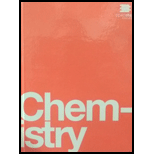
Concept explainers
Explain how
Interpretation: To explain how the sigma (s) and pi (p) bonds are similar and different.
Concept introduction: A sigma bond is formed by the axial overlap of atomic orbitalsand the pi bonds are formed by the side-to-side overlap of p-orbitals.
Answer to Problem 1E
Similarities: Both sigma and pi bonds are formed by the overlapping of orbital and these bonds are covalent bonds.
Differences: Sigma bond is the strong bond whereas pi bond is weaker in comparison to sigma bond.
Pi bond is formed by the side to side overlapping of atomic orbital whereas sigma bond is formed by the linear (end to end) overlapping of atomic orbital.
Explanation of Solution
The sigma and pi both the bonds are formed by sharing of an electron pair that is both are covalent bonds. The sigma bond is formed when two orbitals overlap axially along the internuclear axis; it is strong bond as it requires very high energy to break. The sigma bonds of molecules give the shape of a molecule as per VSEPR model. The sigma bonds can rotate but the pi bonds cannot because if a pi bond is rotated it will break.
Therefore, the similarity between sigma and pi bonds are that both are formed by the overlap of orbital and both the bonds are covalent bonds that is it involves a bond pair. The difference between sigma and pi bonds are that sigma bond is the strongest bond while pi bonds are weaker as compared to sigma bond. Sigma bond is formed by linear overlap of atomic orbital while the pi bond is formed by side-to-side overlap of atomic orbital. Sigma bond gives the shape while a pi bond gives the length of a molecule. Sigma bond is free to rotate around its axis while the pi bond cannot rotate it is locked.
Similarities: Both sigma and pi bonds are formed by the overlapping of orbital and these bonds are covalent bonds.
Differences: Sigma bond is the strong bond whereas pi bond is weaker in comparison to sigma bond.
Pi bond is formed by the side to side overlapping of atomic orbital whereas sigma bond is formed by the linear (end to end) overlapping of atomic orbital.
Want to see more full solutions like this?
Chapter 8 Solutions
Chemistry by OpenStax (2015-05-04)
Additional Science Textbook Solutions
Human Anatomy & Physiology (2nd Edition)
Chemistry: The Central Science (14th Edition)
Biology: Life on Earth with Physiology (11th Edition)
College Physics: A Strategic Approach (3rd Edition)
Campbell Essential Biology (7th Edition)
Microbiology: An Introduction
- Please answer the question for the reactions, thank youarrow_forwardWhat is the product of the following reaction? Please include a detailed explanation of what is happening in this question. Include a drawing showing how the reagent is reacting with the catalyst to produce the correct product. The correct answer is IV.arrow_forwardPlease complete the reactions, thank youarrow_forward
- Consider the synthesis. What is compound Y? Please explain what is happening in this question. Provide a detailed explanation and a drawing to show how the compound Y creates the product. The correct answer is D.arrow_forwardWhat would be the major product of the following reaction? Please include a detailed explanation of what is happening in this question. Include steps and a drawing to show this reaction proceeds and how the final product is formed. The correct answer is B. I put answer D and I don't really understand what is going on in the question.arrow_forwardWhat is the product of the following reaction? Please explain what is happening in this question. Provide a detailed explanation and a drawing showing how the reagent is reacting with the catalysts to product the correct product. The correct answer is B.arrow_forward
- What is the missing intermediate 1 and the final product 2. Please include a detailed explanation explaining the steps of malonic ester synthesis. Please include drawings of the intermediate and how it occurs and how the final product is former.arrow_forwardWhat would be the reagents and conditions above and below the arrow that will complete the proposed acetoacetic ester synthesis? If it cannot be done efficiently, then I will choose that answer. There could be 2 or 4 reagents involved. Please provide a detailed explanation and drawings showing how it would proceed with the correct reagents.arrow_forwardFor benzene, the ∆H° of vaporization is 30.72 kJ/mol and the ∆S° of vaporization is 86.97 J/mol・K. At 1.00 atm and 228.0 K, what is the ∆G° of vaporization for benzene, in kJ/mol?arrow_forward
- The reaction Q(g) + R(g) → Z(l) is shown to be exothermic. Which of the following is true concerning the reaction. it is spontaneous only at High T, it is spontaneous at low T it is nonspontaneous at all T it is spontanrous at all T. it is non spontaneous only at low T.arrow_forwardThe reaction Q(g) + R(g) → Z(l) is shown to be exothermic. Which of the following is true concerning the reactionarrow_forwardWhich of the following has the largest standard molar entropy, S° (298.15 K) He H2 NaCl KBr Hgarrow_forward
 Chemistry: The Molecular ScienceChemistryISBN:9781285199047Author:John W. Moore, Conrad L. StanitskiPublisher:Cengage Learning
Chemistry: The Molecular ScienceChemistryISBN:9781285199047Author:John W. Moore, Conrad L. StanitskiPublisher:Cengage Learning General Chemistry - Standalone book (MindTap Cour...ChemistryISBN:9781305580343Author:Steven D. Gammon, Ebbing, Darrell Ebbing, Steven D., Darrell; Gammon, Darrell Ebbing; Steven D. Gammon, Darrell D.; Gammon, Ebbing; Steven D. Gammon; DarrellPublisher:Cengage Learning
General Chemistry - Standalone book (MindTap Cour...ChemistryISBN:9781305580343Author:Steven D. Gammon, Ebbing, Darrell Ebbing, Steven D., Darrell; Gammon, Darrell Ebbing; Steven D. Gammon, Darrell D.; Gammon, Ebbing; Steven D. Gammon; DarrellPublisher:Cengage Learning Chemistry: Principles and PracticeChemistryISBN:9780534420123Author:Daniel L. Reger, Scott R. Goode, David W. Ball, Edward MercerPublisher:Cengage Learning
Chemistry: Principles and PracticeChemistryISBN:9780534420123Author:Daniel L. Reger, Scott R. Goode, David W. Ball, Edward MercerPublisher:Cengage Learning
 ChemistryChemistryISBN:9781305957404Author:Steven S. Zumdahl, Susan A. Zumdahl, Donald J. DeCostePublisher:Cengage Learning
ChemistryChemistryISBN:9781305957404Author:Steven S. Zumdahl, Susan A. Zumdahl, Donald J. DeCostePublisher:Cengage Learning Chemistry: An Atoms First ApproachChemistryISBN:9781305079243Author:Steven S. Zumdahl, Susan A. ZumdahlPublisher:Cengage Learning
Chemistry: An Atoms First ApproachChemistryISBN:9781305079243Author:Steven S. Zumdahl, Susan A. ZumdahlPublisher:Cengage Learning





